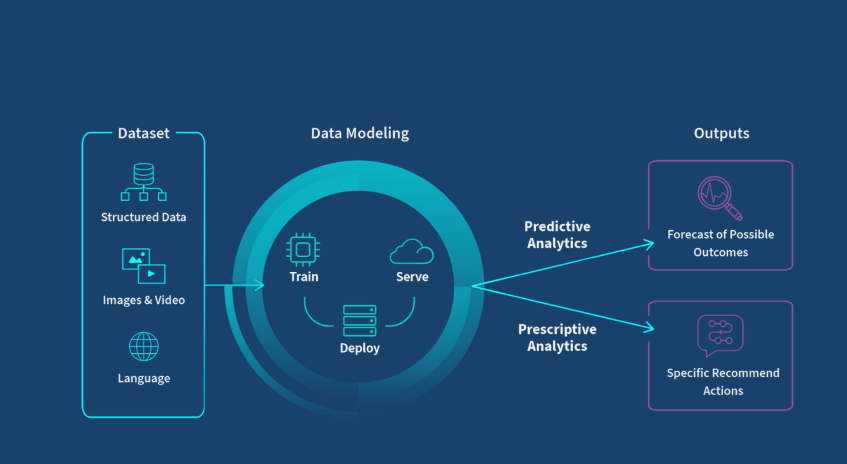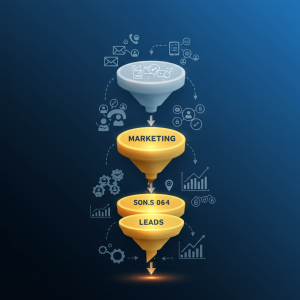Predictive Analytics: Forecasting Marketing Outcomes with AI

Marketing has always involved educated guesswork – attempting to anticipate what campaigns might resonate, which customers might convert, and how market conditions might evolve. Today, predictive analytics transforms this approximation art into precision science by leveraging historical patterns to forecast future outcomes with remarkable accuracy. At BrandsDad, we’ve witnessed firsthand how organizations adopting predictive capabilities consistently outperform competitors relying on retrospective analysis alone.
The Evolution Beyond Retrospective Analysis
Traditional marketing analytics operated primarily in hindsight, examining what happened and why after campaigns concluded. While valuable for learning, this retrospective approach limited strategic agility. Marketers needed to complete entire campaign cycles before gaining actionable insights, creating lengthy feedback loops between strategy adjustments.
Predictive analytics fundamentally transforms this dynamic by shifting analytical focus from explaining past outcomes toward anticipating future behaviors. Rather than simply understanding what worked previously, predictive approaches forecast what will likely work next, enabling proactive strategy refinement before investing significant resources.
This capability shift parallels weather forecasting evolution. Early meteorologists could only explain weather patterns after they occurred, while modern forecasting combines historical data with atmospheric modeling to predict conditions days in advance. Marketing now undergoes similar transformation from descriptive toward predictive capabilities.
Core Predictive Modeling Approaches
Several analytical methodologies form the foundation of marketing prediction systems:
Regression modeling examines relationships between variables to project how changing conditions might influence outcomes. These approaches might predict how pricing adjustments will impact conversion rates or how seasonal factors will influence search volumes.
Classification algorithms identify which category new observations likely belong to based on historical patterns. These techniques help determine which prospective customers resemble previous converters or which leads demonstrate characteristics similar to successful sales opportunities.
Time-series analysis specifically examines how metrics evolve over time, accounting for seasonality, trend patterns, and cyclical fluctuations. These approaches excel at forecasting future performance trajectories based on historical progression.
Clustering techniques identify natural groupings within data, revealing customer segments exhibiting similar behavior patterns. These naturally occurring segments often provide more predictive value than artificially constructed categories.
Machine learning techniques increasingly enhance these foundational approaches by uncovering complex non-linear relationships traditional statistics might miss. According to research from McKinsey Global Institute, organizations implementing machine learning for marketing prediction typically achieve 15-30% improvement in forecast accuracy compared to traditional statistical modeling alone.
Transformative Marketing Applications
Predictive capabilities transform numerous marketing functions:
Customer acquisition becomes significantly more efficient through propensity modeling identifying which prospects most likely convert. Rather than treating all potential customers equally, organizations direct resources toward individuals demonstrating characteristics matching previous successful conversions.
Retention programs benefit tremendously from churn prediction identifying at-risk customers before they demonstrate explicit departure signals. This early identification creates intervention windows when customer relationships remain salvageable rather than after decision finalization.
Content strategy gains precision through anticipating which topics, formats, and distribution channels will generate strongest engagement based on historical performance patterns and emerging trends.
Budget allocation improves dramatically through forecasting expected returns across different channels and tactics before investment commitments. These projections enable optimization across marketing mix elements beyond what retrospective analysis alone could achieve.
Campaign timing becomes more strategic through predicting seasonal demand fluctuations, competitive activity patterns, and optimal launch windows for maximum impact.
Each application moves marketing further from intuition-based decisions toward data-driven strategies with significantly higher success probability. According to Gartner Research, organizations consistently using predictive analytics for campaign planning achieve 25-45% higher marketing ROI than those primarily using retrospective measurement approaches.
From Broad Trends to Individual Predictions
Perhaps the most powerful aspect of modern predictive analytics involves progression from general market forecasting toward individual-level predictions. Rather than merely anticipating overall trends, sophisticated systems now forecast specific behaviors for individual customers or narrow segments.
This granularity enables personalization at unprecedented scale. Organizations can anticipate not just what products might interest which customers, but also identify optimal messaging approaches, timing preferences, offer sensitivity, and channel preferences for individual relationships.
The progression resembles medicine’s evolution from general population health trends toward precision treatments based on individual patient characteristics. Just as medical treatments increasingly reflect specific patient attributes rather than average population responses, marketing increasingly delivers experiences tailored to individual predicted preferences rather than broad demographic assumptions.
Implementation Foundations
Building effective predictive capabilities requires several foundational elements:
Data infrastructure providing consolidated access to relevant historical information from across marketing channels, sales systems, product interactions, and external sources. Prediction quality fundamentally depends on comprehensive historical data availability.
Modeling expertise combining statistical knowledge with domain understanding to develop meaningful predictive frameworks. These specialized skills increasingly merge data science capabilities with marketing strategy comprehension.
Testing methodologies validating predictive accuracy through structured holdout approaches comparing forecasted outcomes against actual results. These validation processes provide crucial confidence measures before applying predictions to major decisions.
Organizational adoption pathways translating predictive insights into operational decisions. Technical capabilities generate value only when predictions actually influence strategic choices and tactical execution.
Organizations building these foundations systematically develop sustainable competitive advantages through their predictive capabilities rather than achieving merely temporary tactical gains.
Beyond Marketing: Connected Predictive Systems
The most sophisticated predictive implementations extend beyond marketing alone into integrated business forecasting frameworks. These connected systems link marketing predictions with broader operational forecasting for truly coordinated business planning.
For example, marketing campaign predictions might directly inform inventory planning, ensuring product availability aligns precisely with anticipated demand surges. Similarly, salesforce staffing decisions might reflect predicted lead volume and conversion timing from upcoming marketing initiatives.
This integration elevates marketing analytics from departmental measurement tool to strategic business planning asset with organization-wide impact. Rather than operating as isolated function, marketing becomes integral component within comprehensive predictive business systems.
Ethical Considerations in Predictive Marketing
Responsible predictive implementation requires thoughtful ethical consideration:
Prediction explainability ensures organizations understand why systems forecast specific outcomes rather than treating algorithms as inscrutable black boxes. This understanding proves crucial for identifying potential biases or limitations in predictive frameworks.
Privacy boundaries establish clear limitations on how individual behavioral predictions inform marketing approaches. Respecting these boundaries maintains customer trust while still leveraging aggregate predictive insights.
Accuracy transparency acknowledges prediction confidence levels rather than treating all forecasts with equal certainty. This transparency prevents overconfident decision-making based on highly tentative projections.
Organizations establishing clear ethical frameworks for prediction usage typically build stronger customer relationships while avoiding regulatory complications and reputational risks.
Predictive Maturity Evolution
Organizations typically progress through several predictive capability stages:
Initial implementation focuses on straightforward forecasting applications with clear data availability and well-established methodologies. These might include basic conversion rate predictions or seasonal trend forecasting.
Intermediate applications expand toward more complex behavioral predictions requiring deeper data integration and more sophisticated modeling approaches. These implementations might include customer lifetime value forecasting or multi-touch attribution modeling.
Advanced systems incorporate unstructured data sources like social sentiment, image recognition, and natural language understanding to enhance prediction accuracy beyond what structured data alone enables.
Transformational applications fundamentally reshape business models through predictive capabilities informing product development, market expansion, and strategic investment decisions beyond traditional marketing activities.
This evolutionary progression typically unfolds over several years as organizations build both technical capabilities and organizational adoption patterns necessary for increasingly sophisticated applications.
The Human Element in Predictive Success
While technical capabilities form necessary foundation for predictive analytics, human judgment remains essential for effective implementation. Successful organizations maintain healthy balance between algorithmic forecasts and human strategic thinking rather than simply automating decisions based on predictions alone.
This balance recognizes that predictive models excel at identifying patterns within domains similar to historical examples but cannot anticipate fundamental market disruptions or novel conditions without precedent. Human judgment complements these capabilities by incorporating broader contextual understanding, anticipating unique circumstances, and recognizing limitations in historical data relevance.
The most effective approaches combine prediction accuracy with interpretive insight—understanding not just what outcomes models forecast but why they anticipate those results. This explanatory dimension transforms predictions from mere outputs into strategic learning tools building deeper market understanding alongside specific forecasts.
Prediction Through Economic Fluctuations
Economic volatility creates particular challenges for predictive analytics by potentially reducing historical data relevance during significant market shifts. Organizations maintaining effective forecasting capabilities during economic transitions typically employ several adaptation strategies:
Scenario-based modeling examines prediction variations under different economic assumptions rather than producing single-point forecasts. These approaches acknowledge uncertainty while still providing structured decision guidance.
Rapid retraining accelerates model update cycles during volatile periods to incorporate emerging patterns more quickly. These compressed timeframes help models adapt to changing conditions faster than standard update schedules would allow.
External factor incorporation explicitly includes economic indicators within prediction frameworks rather than treating them as external contexts. This integration helps models adjust automatically as conditions shift.
These adaptive approaches maintain prediction relevance even when historic patterns face disruption from broader economic changes.
Looking Forward: Prediction Frontiers
Several emerging developments promise to further advance marketing prediction capabilities:
Federated learning approaches develop predictive insights across distributed data sources without requiring centralized information consolidation. These techniques help organizations overcome data silos while respecting privacy boundaries.
Generative AI increasingly complements traditional predictive analytics by not only forecasting what might happen but also generating specific content optimized for predicted preferences. These capabilities enable automated creative optimization based on performance predictions.
Causal modeling moves beyond correlation toward understanding cause-effect relationships driving outcomes. These approaches help distinguish which marketing actions genuinely influence results versus which merely correlate with outcomes driven by other factors.
Each frontier represents significant opportunity for organizations seeking continued competitive advantage through enhanced predictive capabilities.
Conclusion: Prediction as Competitive Requirement
Predictive analytics has rapidly evolved from innovative luxury to competitive necessity for marketing organizations operating in data-rich environments. The ability to anticipate outcomes before investing resources increasingly separates marketing leaders from laggards across industries and sectors.
Organizations building systematic predictive capabilities gain numerous advantages: more efficient resource allocation, earlier trend identification, more personalized customer engagement, and ultimately superior marketing returns. These advantages compound over time as prediction accuracy improves through continuous learning and refinement.
At BrandsDad, we help organizations develop practical predictive capabilities that deliver measurable performance improvements rather than theoretical insights alone. We believe effective prediction fundamentally transforms marketing from retrospective measurement function toward forward-looking strategic discipline with unprecedented business impact.








